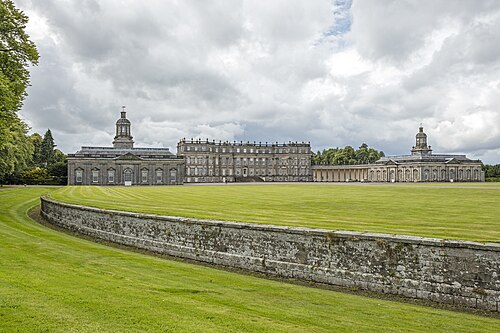From today's featured articleTirpitz was the second of two Bismarck-class battleships built for Nazi Germany during World War II. The ship was laid down in November 1936 and commissioned in February 1941. Tirpitz was armed with a main battery of eight 38-centimetre (15 in) guns in four twin turrets. She was the heaviest battleship ever built by a European navy. In early 1942, the ship sailed to Norway to act as a fleet in being, forcing the British navy to retain significant forces in the area. In September 1943, Tirpitz, along with the battleship Scharnhorst, bombarded Allied positions on Spitzbergen, the only time the ship's main battery was used offensively. On 12 November 1944, British Lancaster bombers equipped with 12,000-pound (5,400 kg) "Tallboys" bombed the ship, causing her to capsize. A deck fire spread to an ammunition magazine causing a large explosion. Between 1948 and 1957, the wreck was broken up in a salvage operation. (This article is part of a featured topic: Battleships of Germany.)
Recently featured:
Did you know ...
|
In the news
On this dayApril 1: Iranian Islamic Republic Day (1979); Edible Book Day
Sophie Germain (b. 1776) · Shivakumara Swami (b. 1907) · Marvin Gaye (d. 1984) |
Today's featured picture

|
|
A ha-ha is a recessed landscape design element that creates a vertical barrier while preserving an uninterrupted view of the landscape beyond. The design includes a turfed incline that slopes downward to a sharply vertical face, typically a masonry retaining wall. Ha-has are used in landscape design to prevent access to a garden, for example by grazing livestock, without obstructing views. In security design, the element is used to deter vehicular access to a site while minimizing visual obstruction. The name "ha-ha" is thought to have stemmed from the exclamations of surprise by those coming across them, as the walls were intentionally designed so as not to be visible on the plane of the landscape. This picture shows a ha-ha at Hopetoun House in West Lothian, Scotland, which keeps animals off the lawn while remaining unseen from the main house, visible here in the background. The wall disappears from view as it curves away to the left of the photograph. Photograph credit: Andrew Shiva
Recently featured:
|
Other areas of Wikipedia
- Community portal – Bulletin board, projects, resources and activities covering a wide range of Wikipedia areas.
- Help desk – Ask questions about using Wikipedia.
- Local embassy – For Wikipedia-related communication in languages other than English.
- Reference desk – Serving as virtual librarians, Wikipedia volunteers tackle your questions on a wide range of subjects.
- Site news – Announcements, updates, articles and press releases on Wikipedia and the Wikimedia Foundation.
- Village pump – For discussions about Wikipedia itself, including areas for technical issues and policies.
Wikipedia's sister projects
Wikipedia is hosted by the Wikimedia Foundation, a non-profit organization that also hosts a range of other projects:
Free media repository
Wiki software development
Wikimedia project coordination
Free textbooks and manuals
Free knowledge base
Free-content news
Collection of quotations
Free-content library
Directory of species
Free learning materials and activities
Free travel guide
Dictionary and thesaurus



